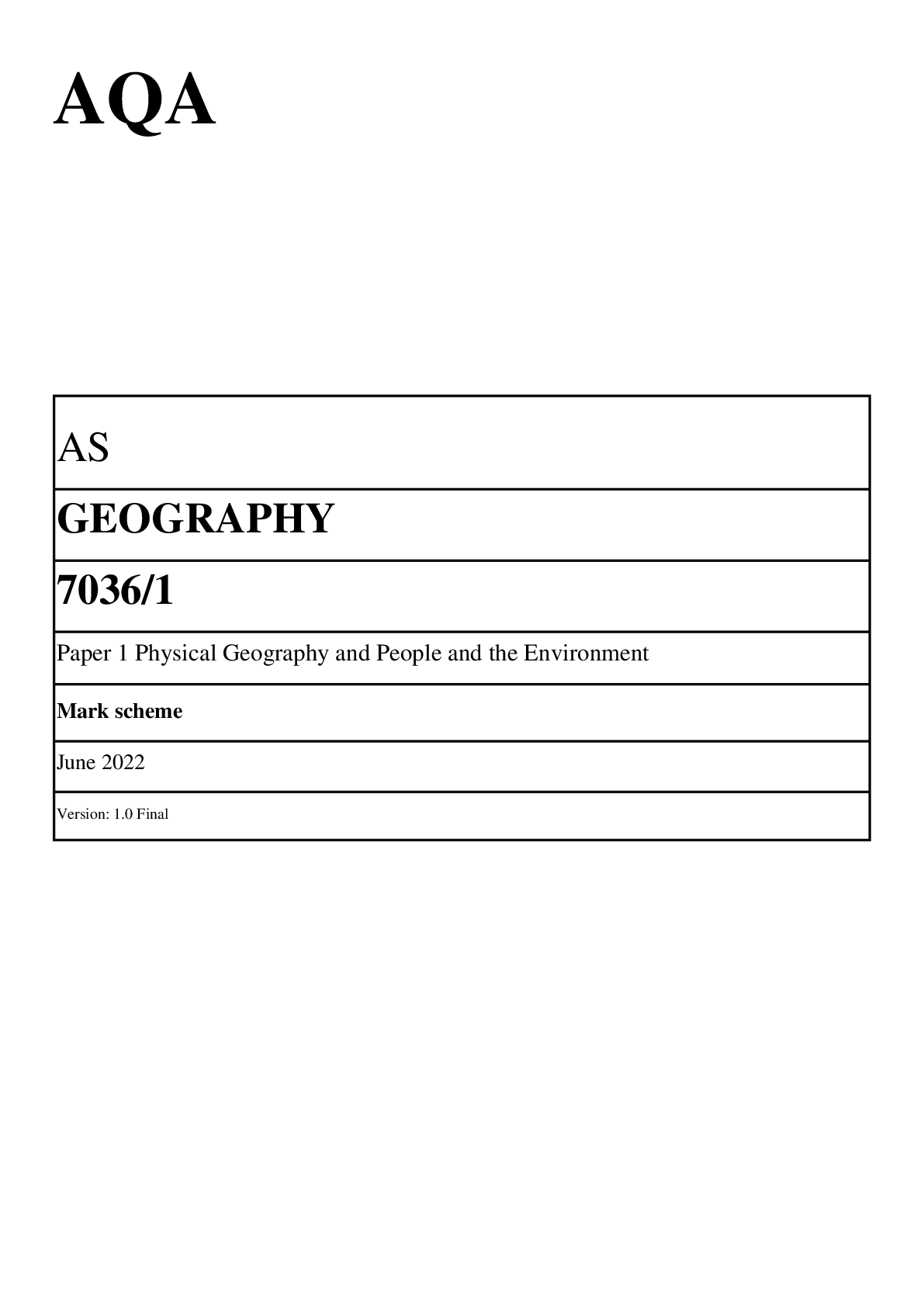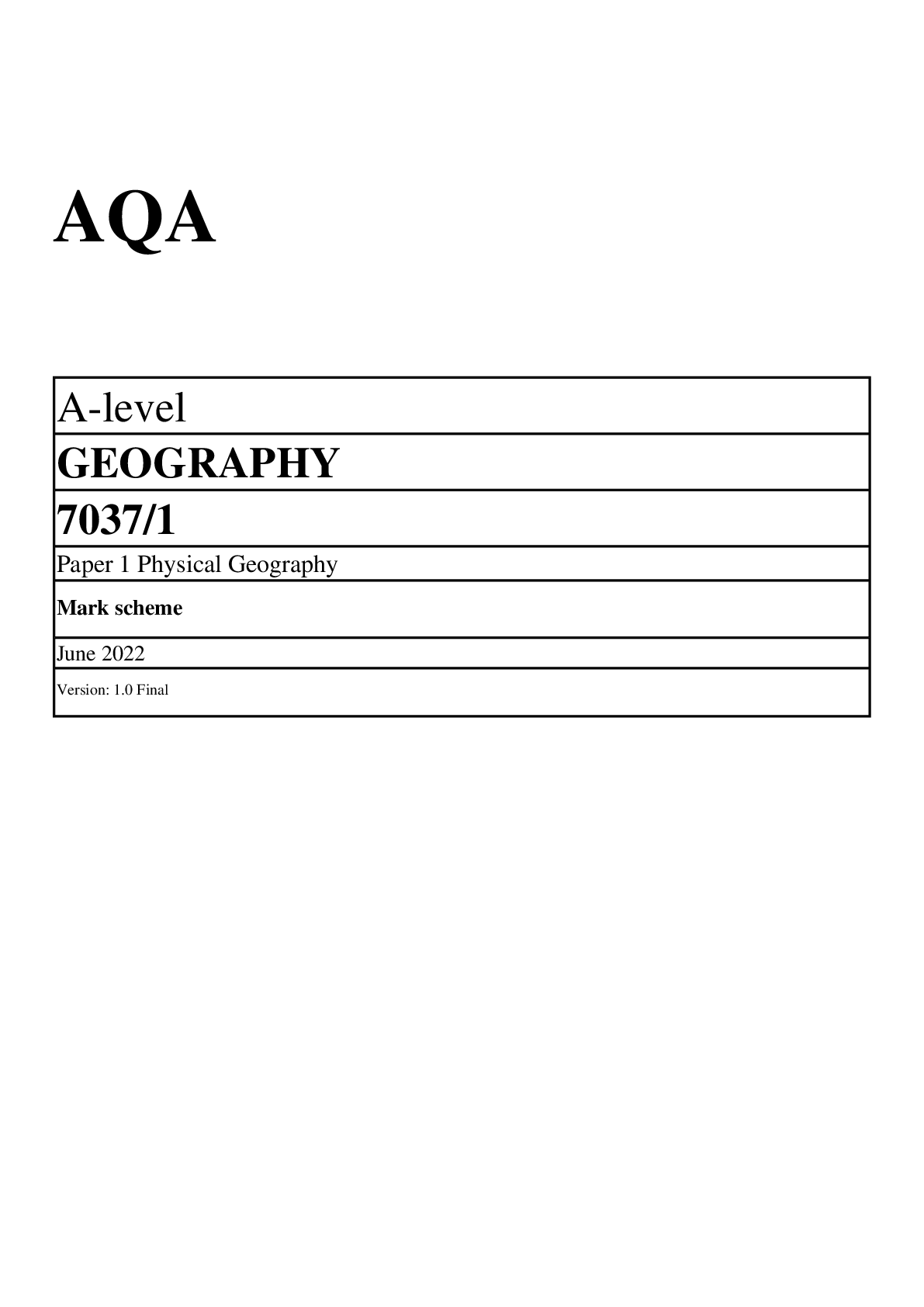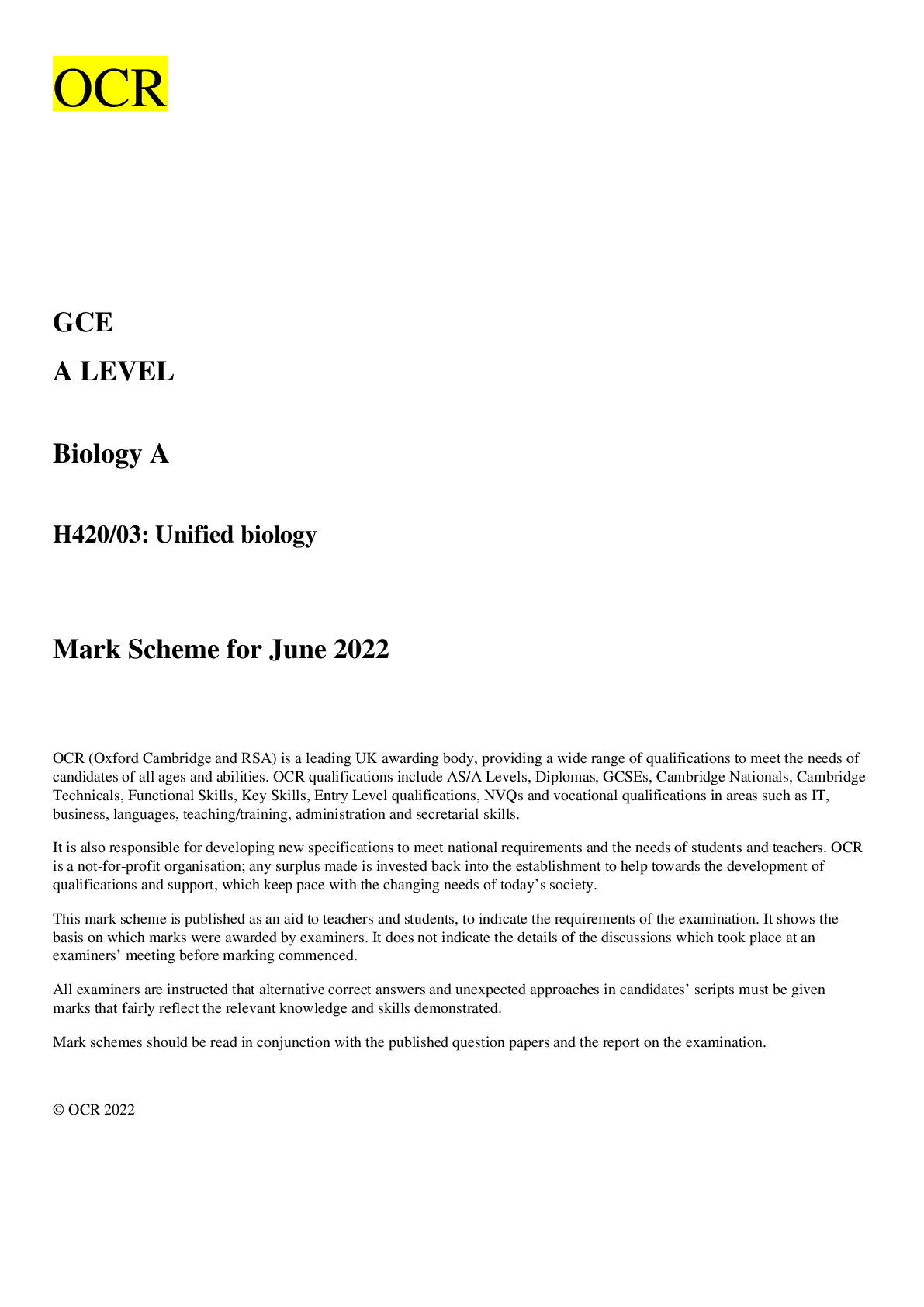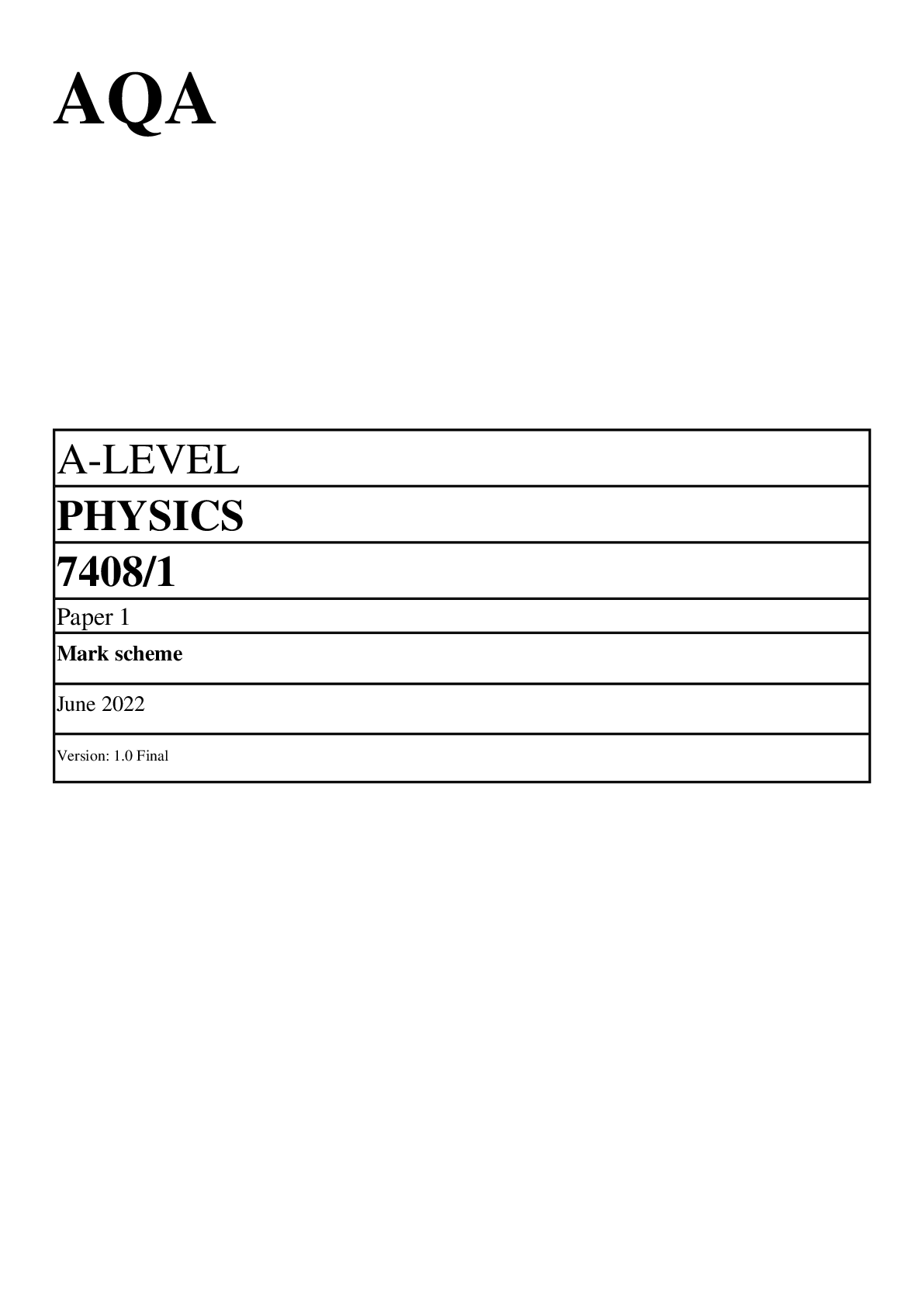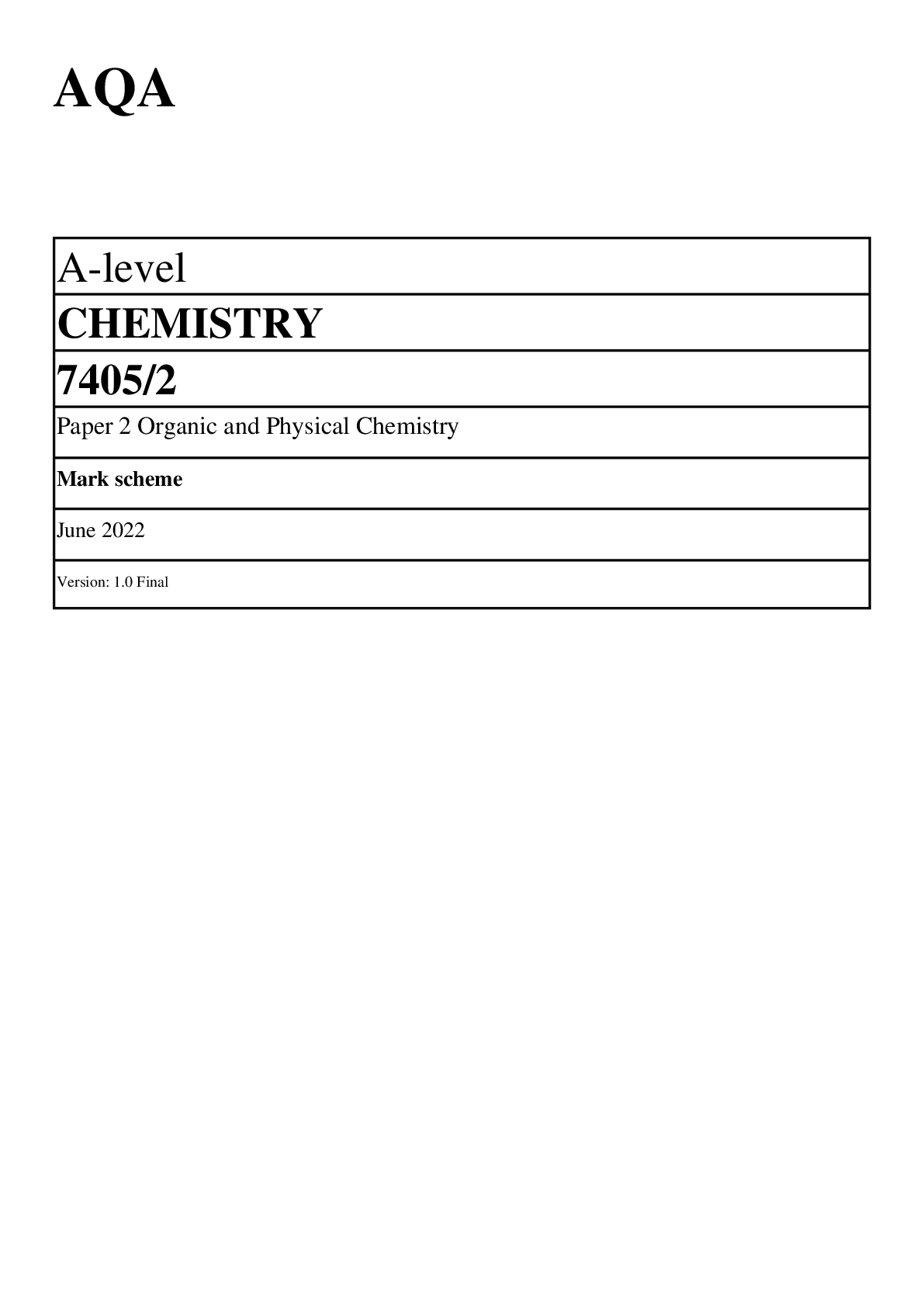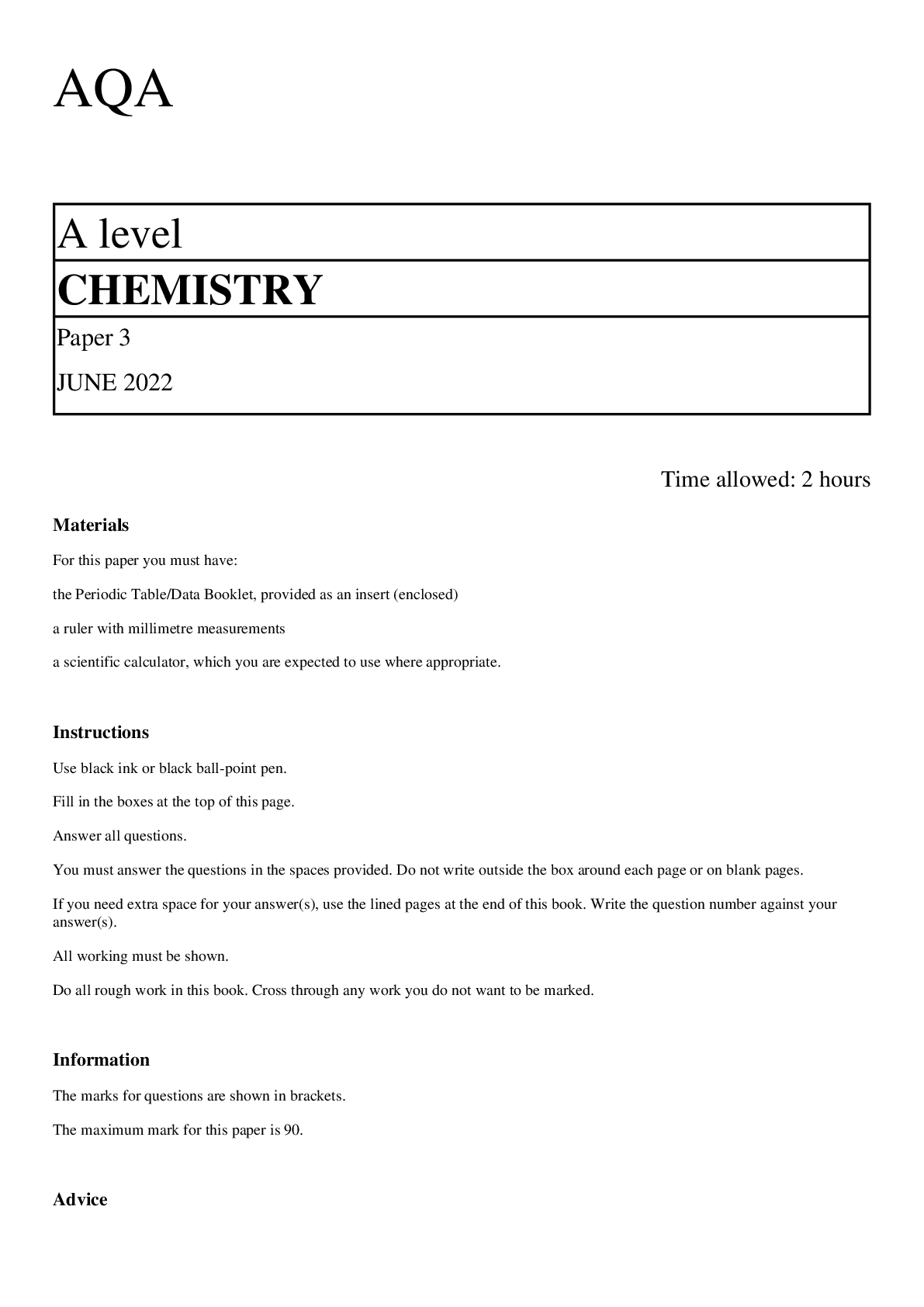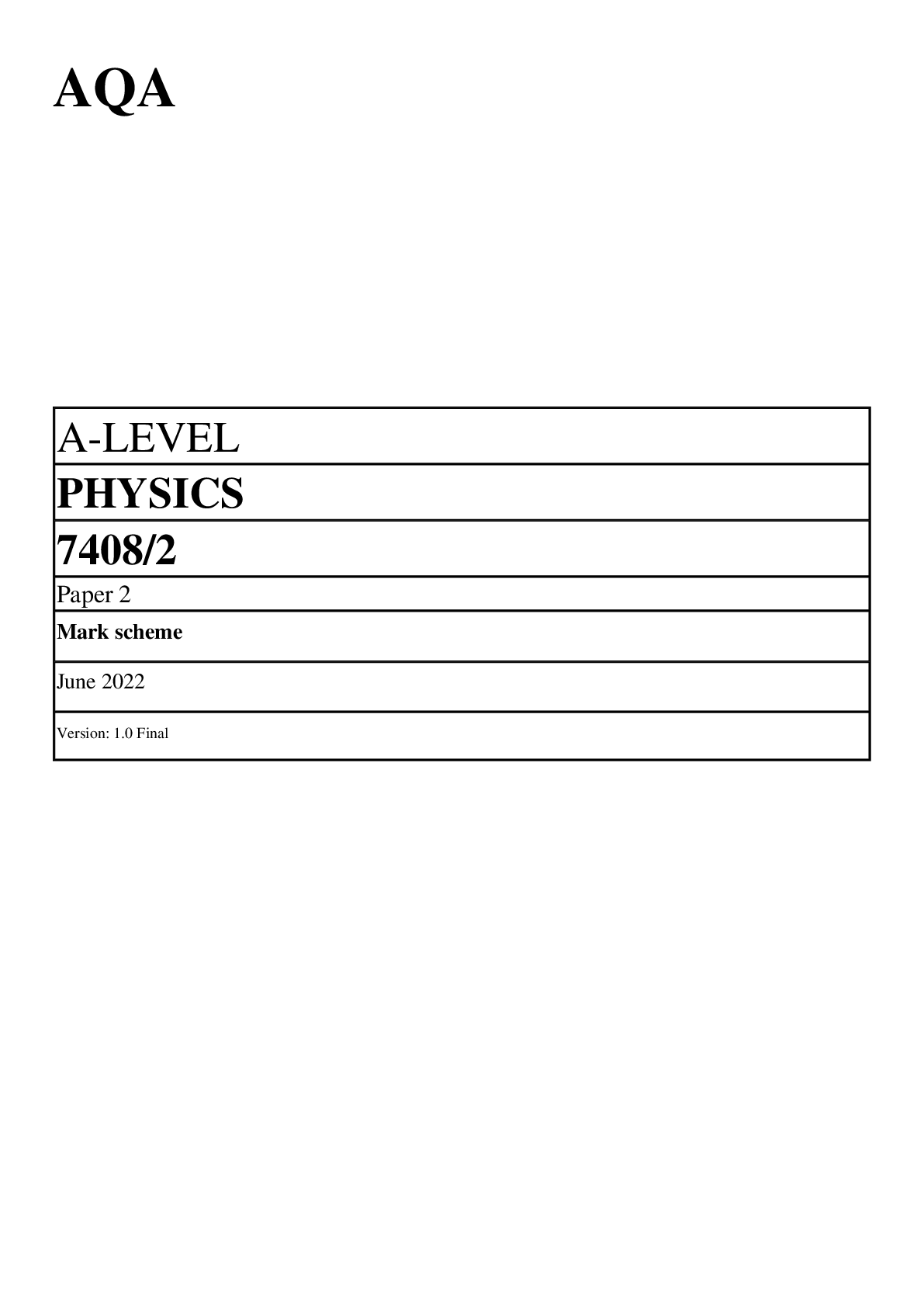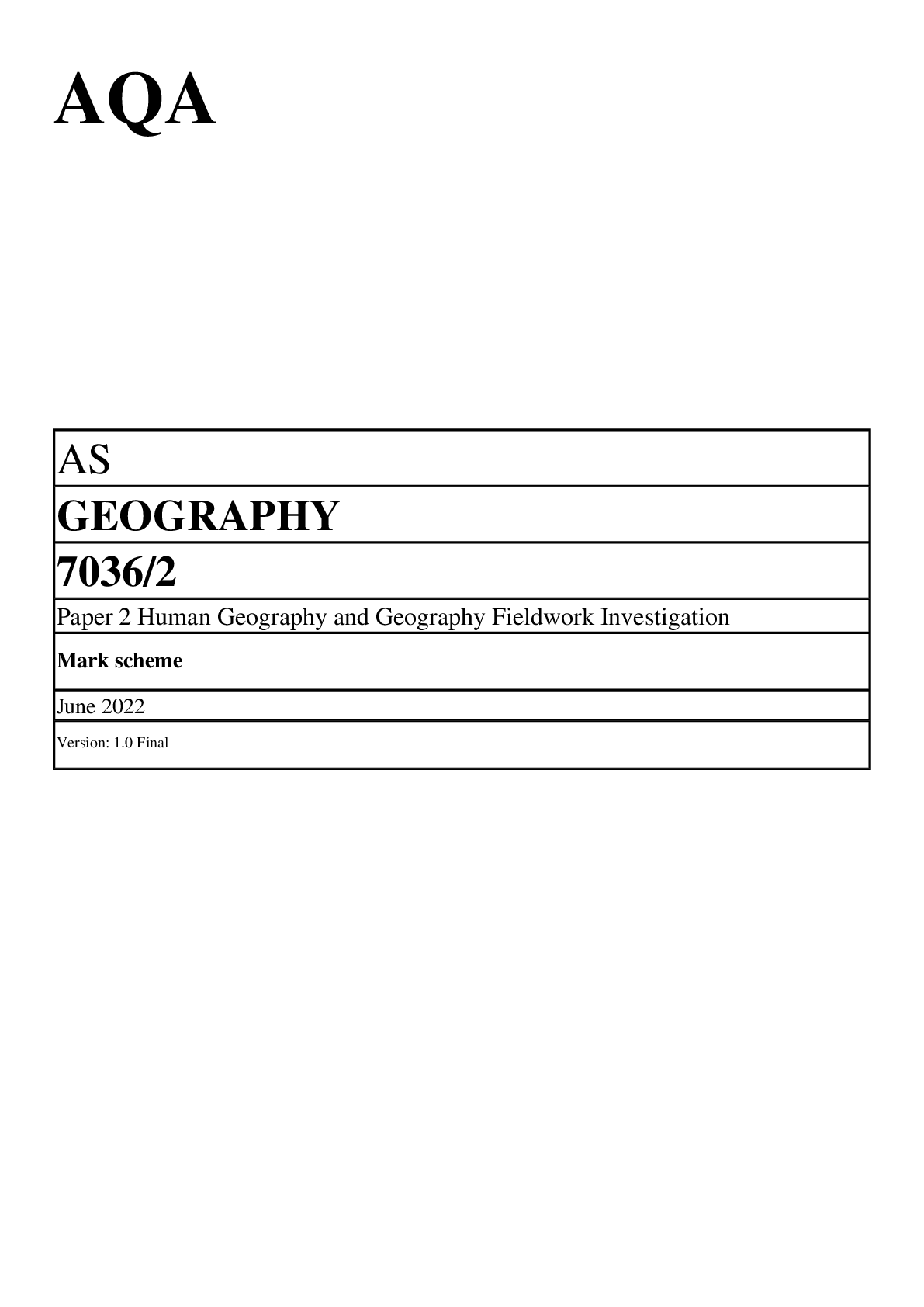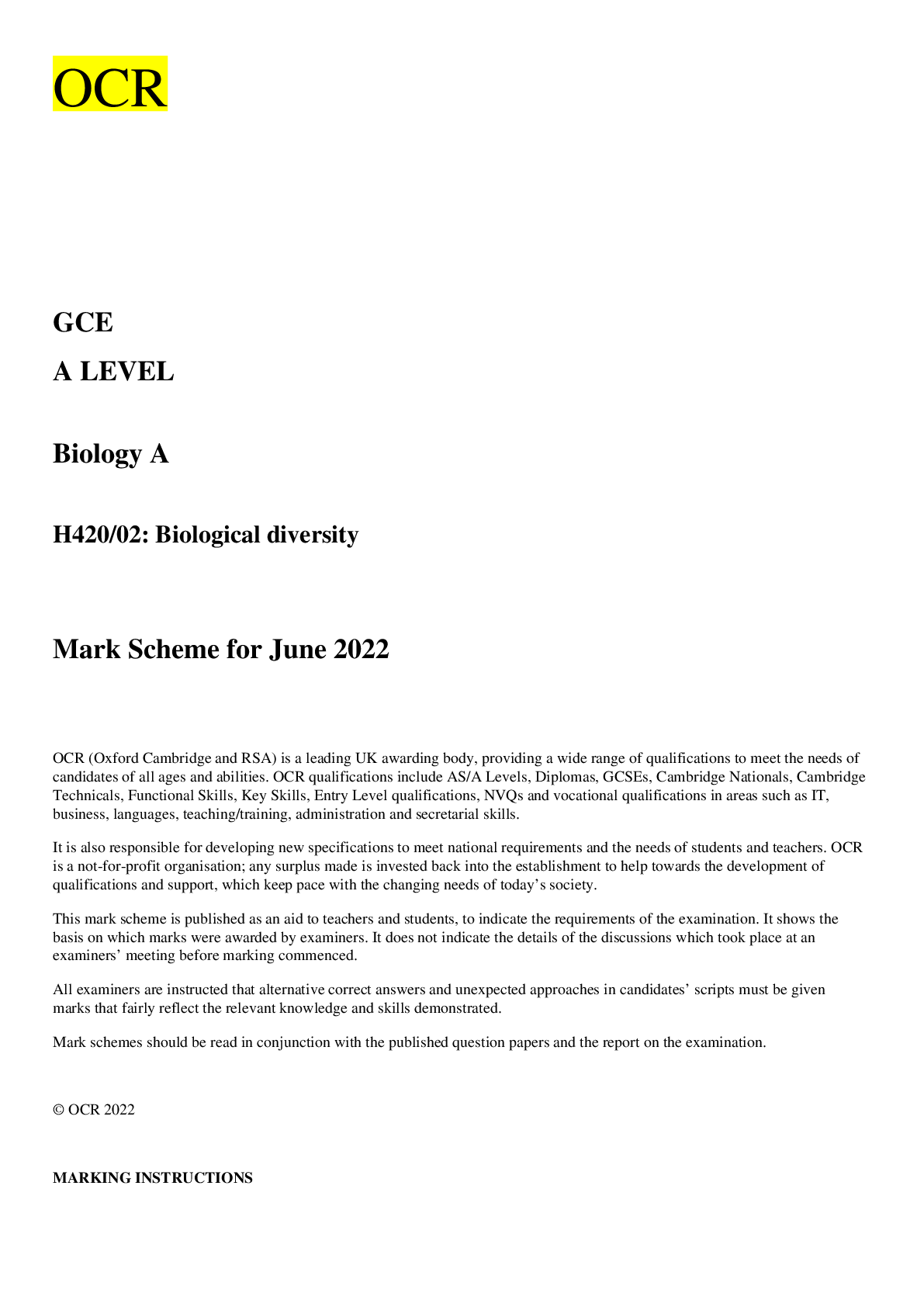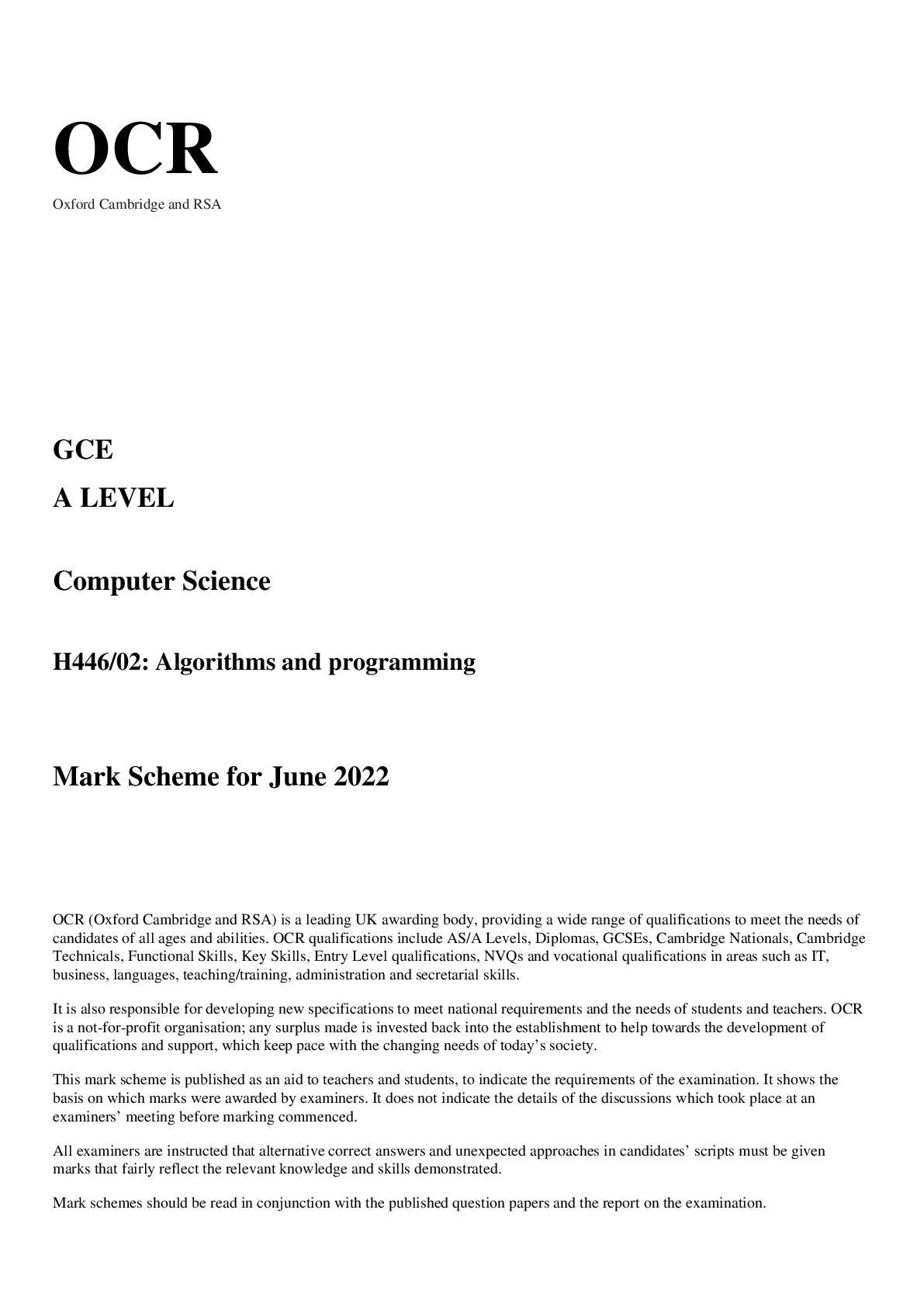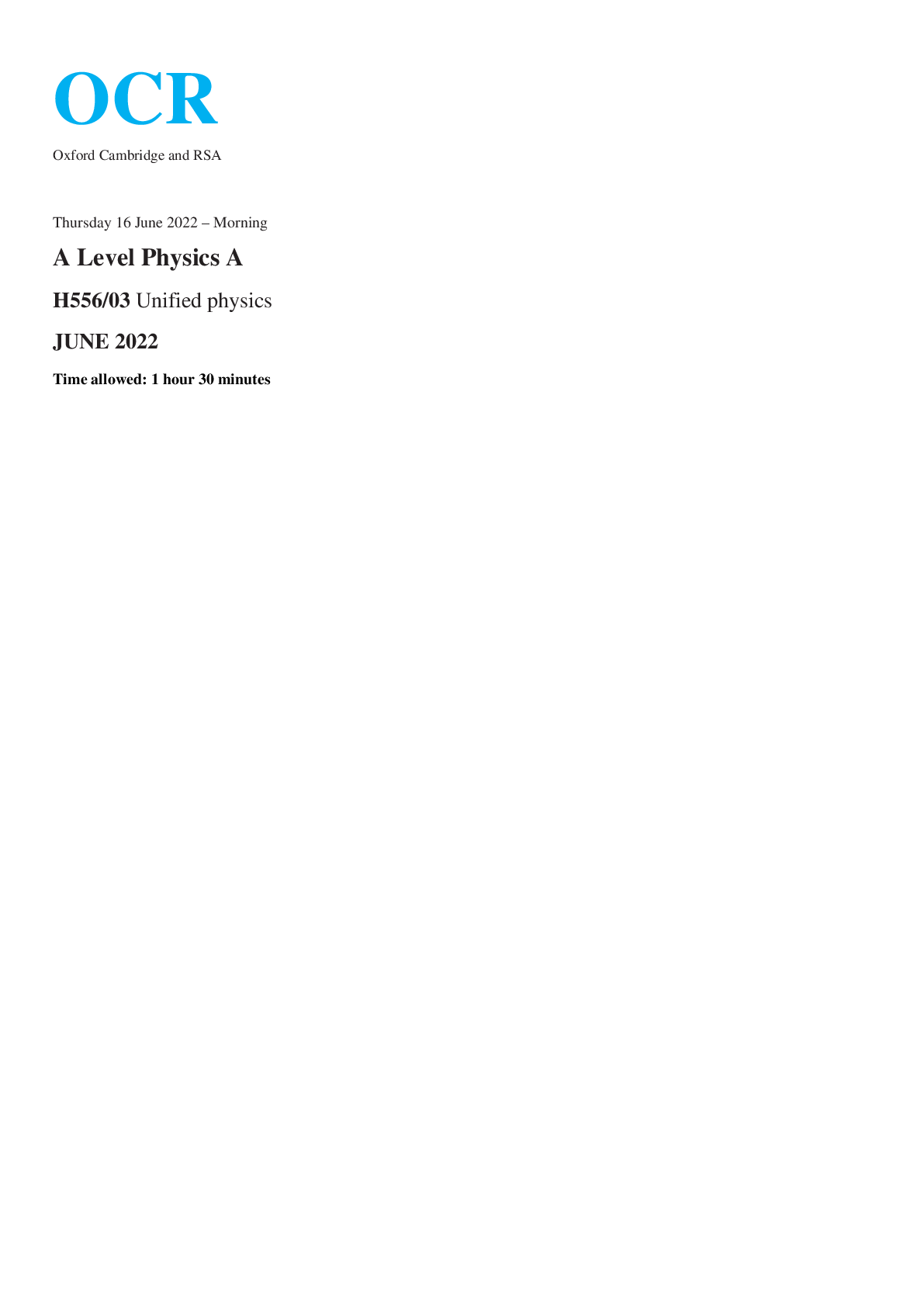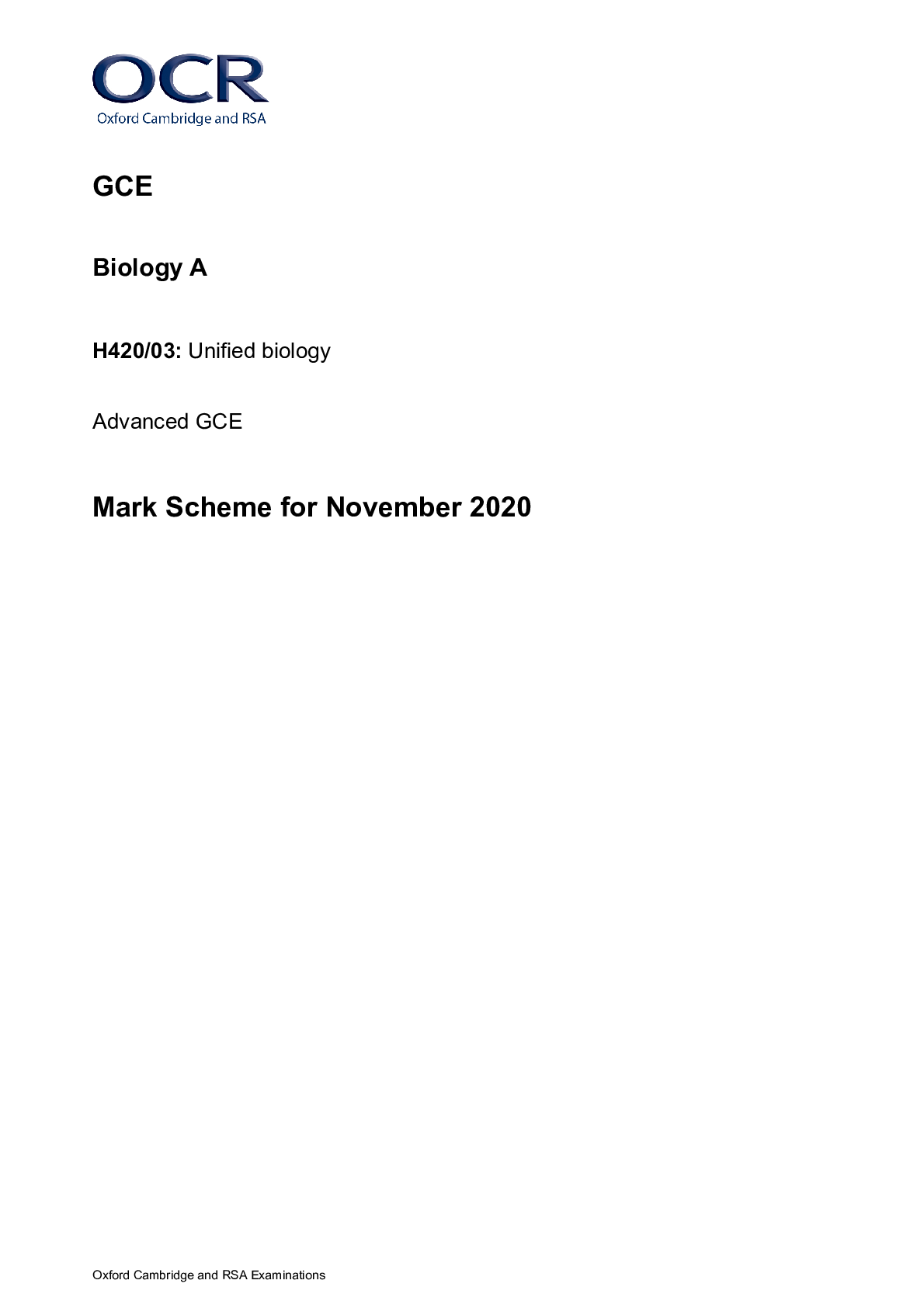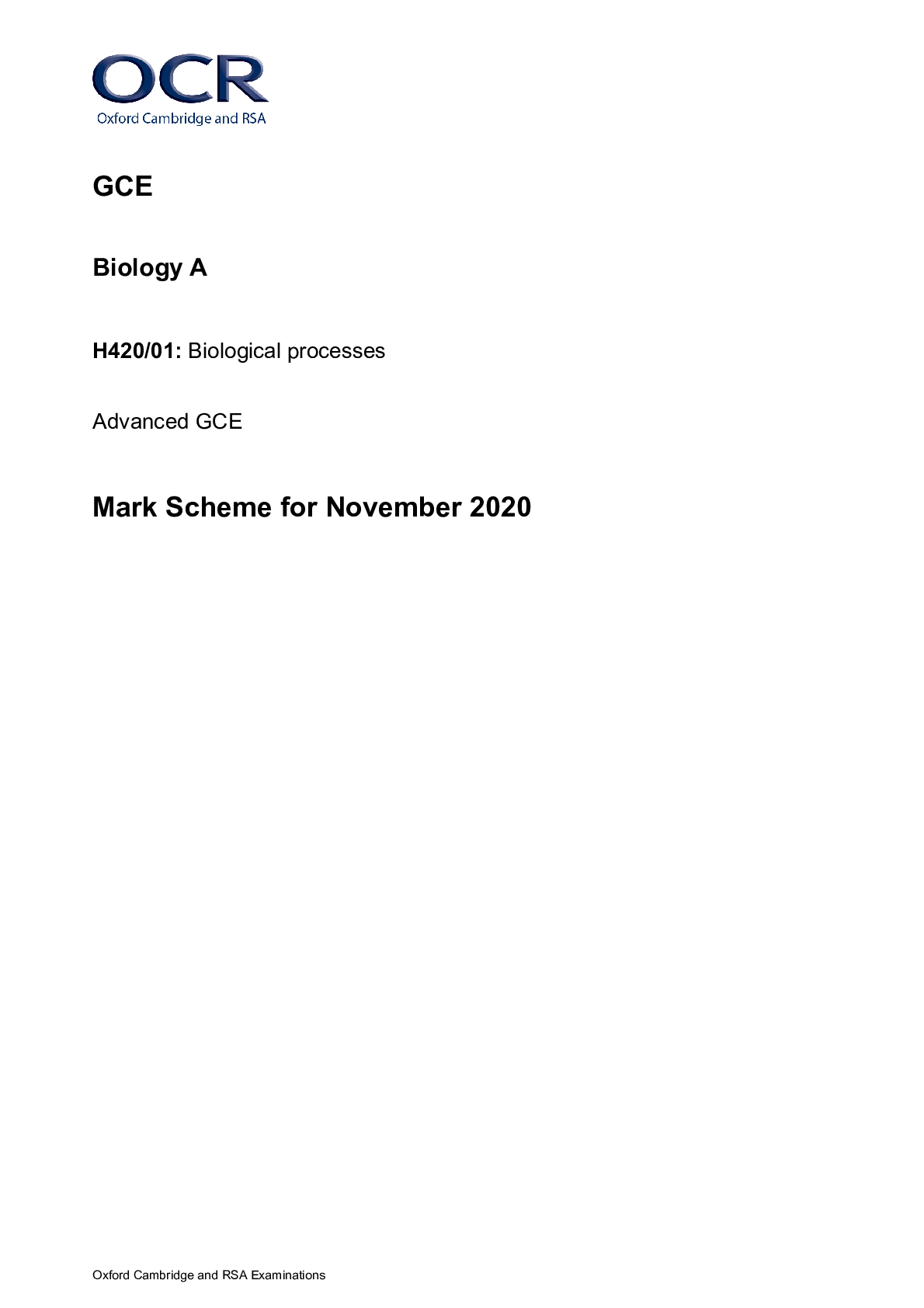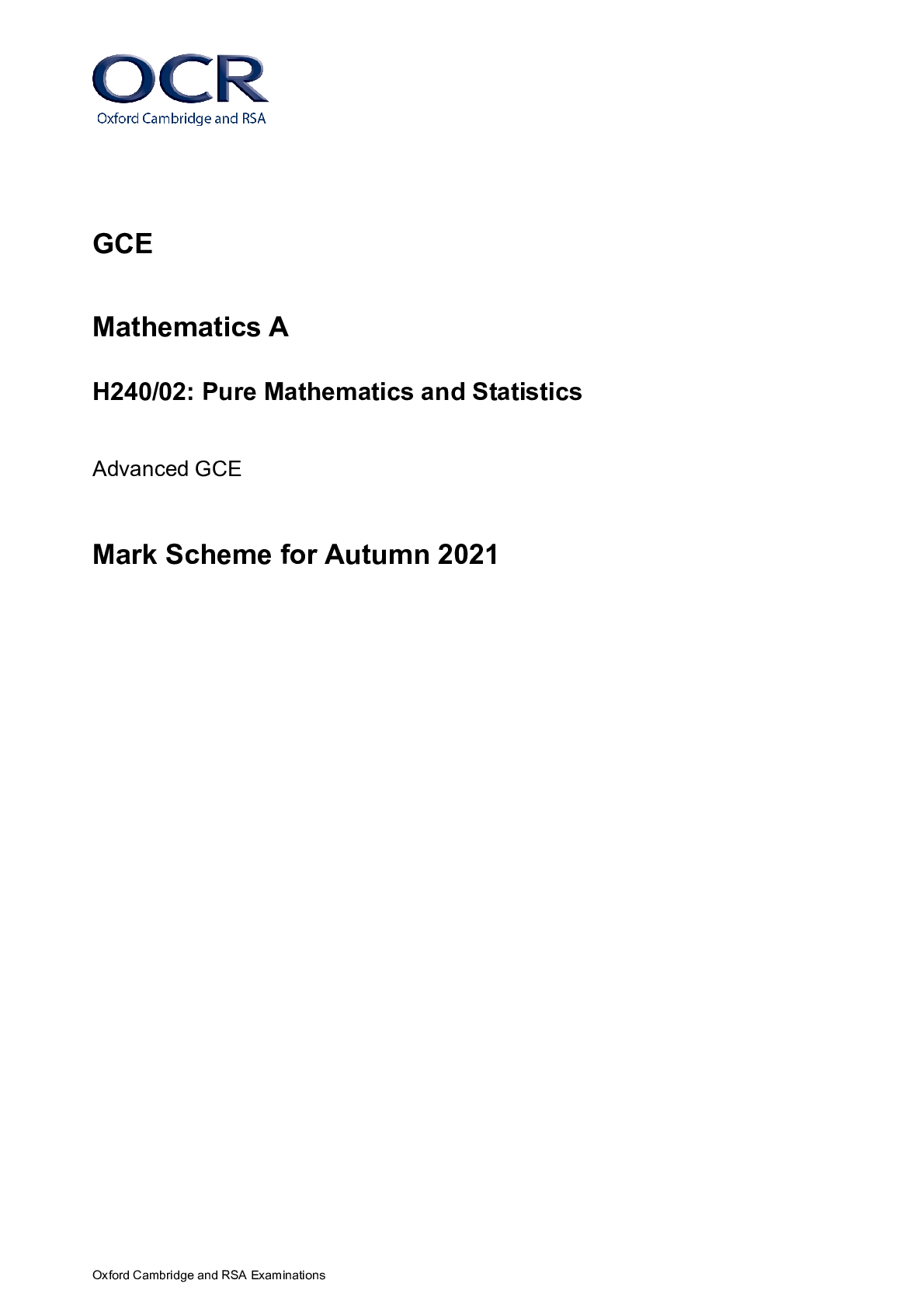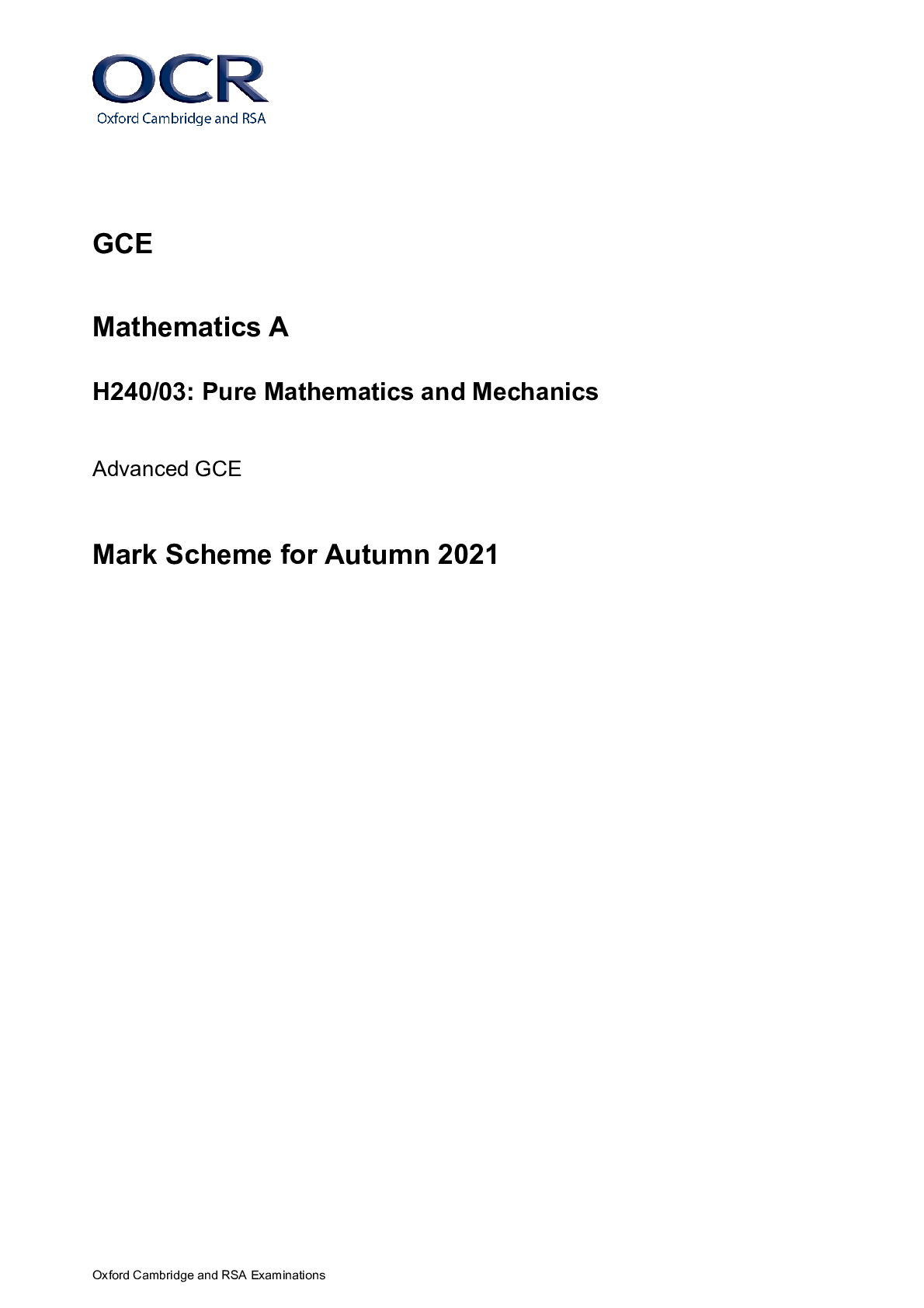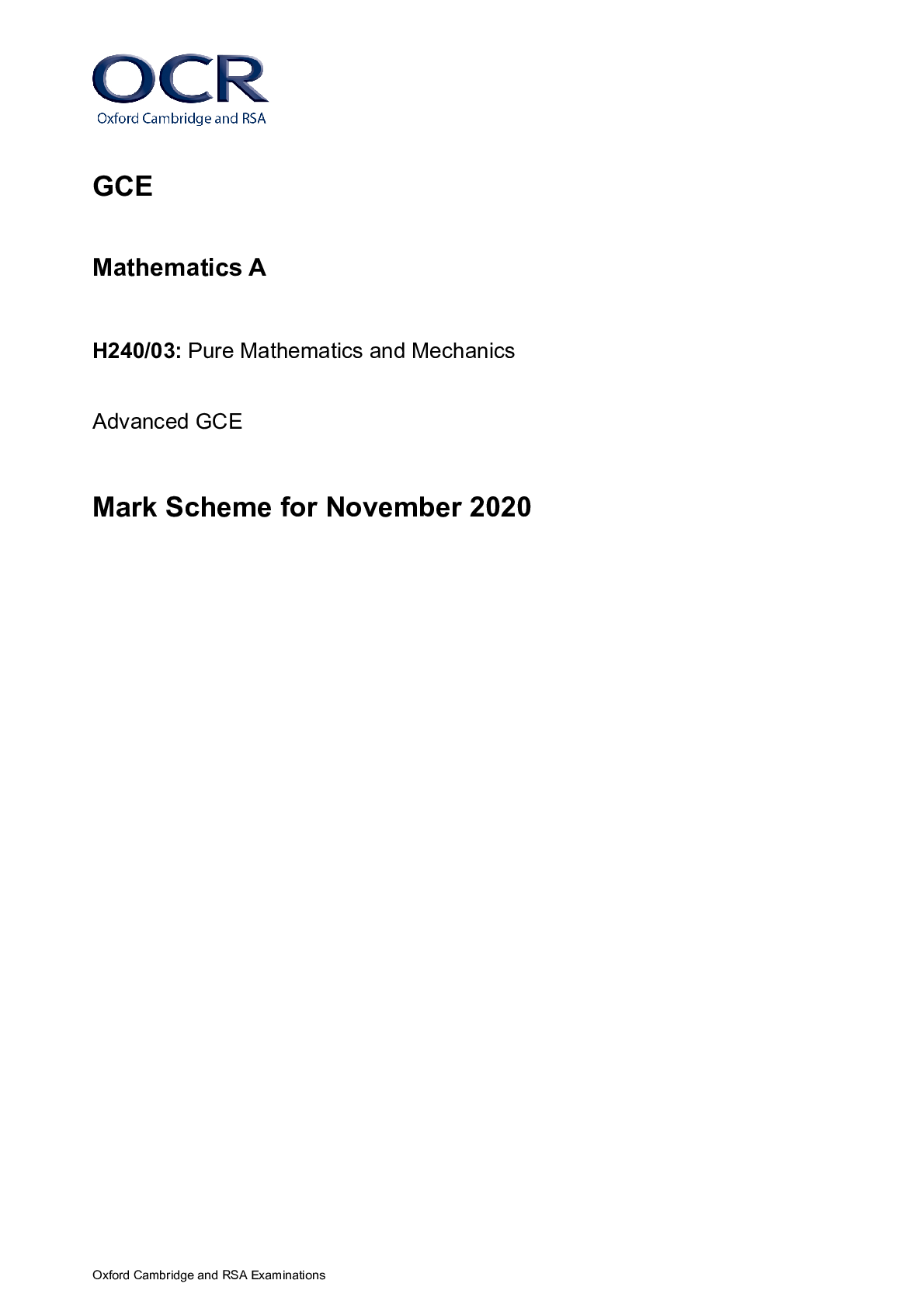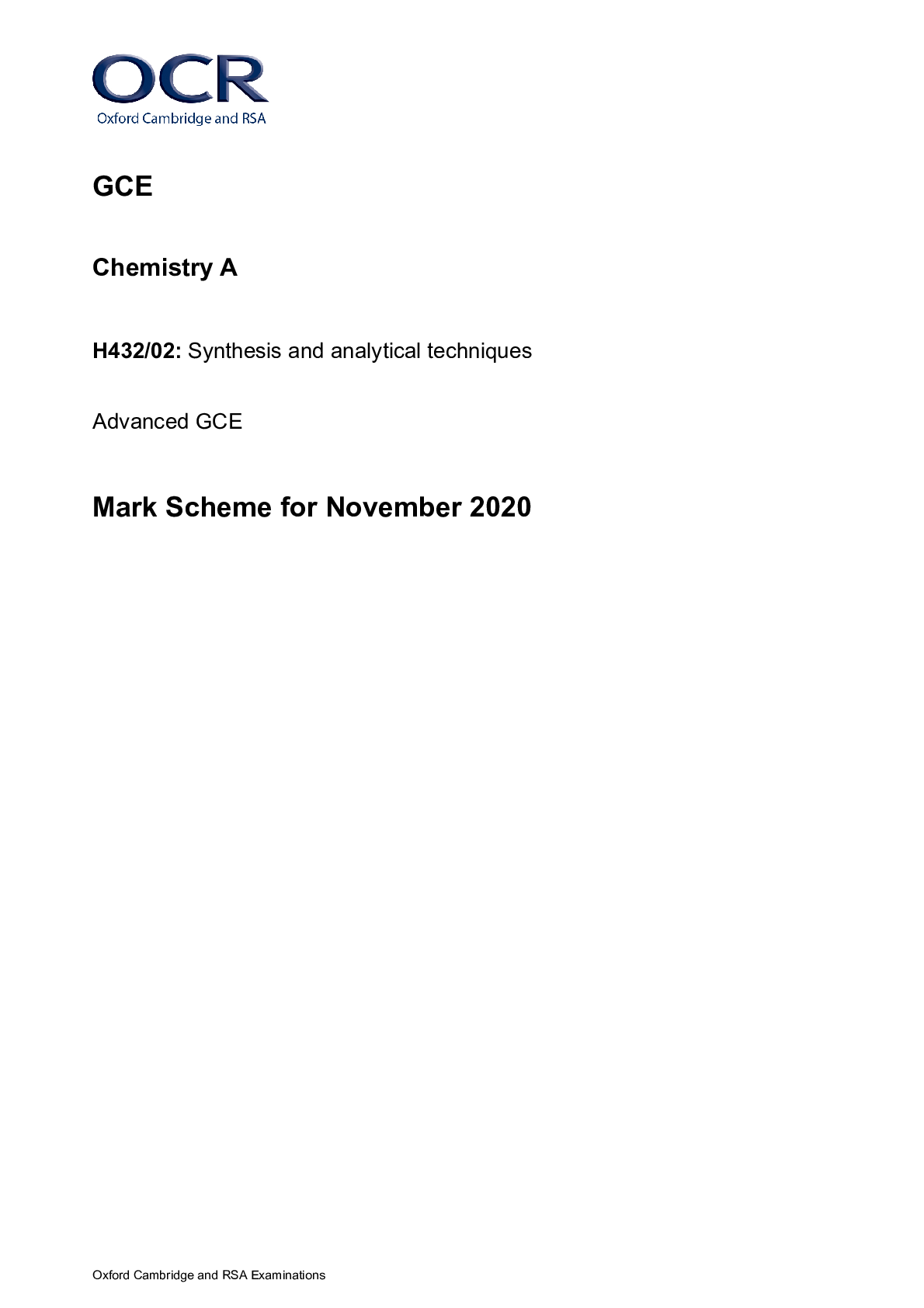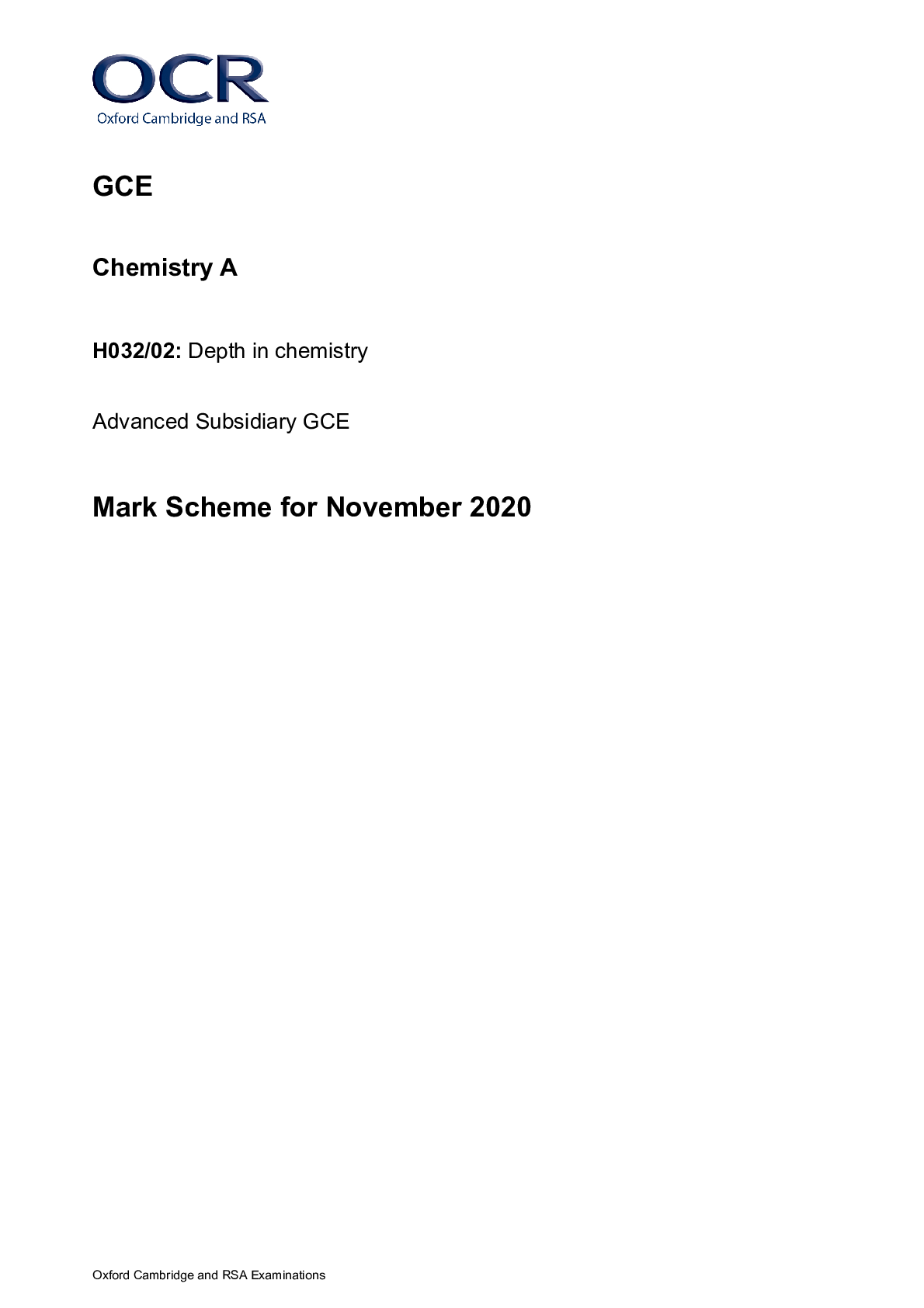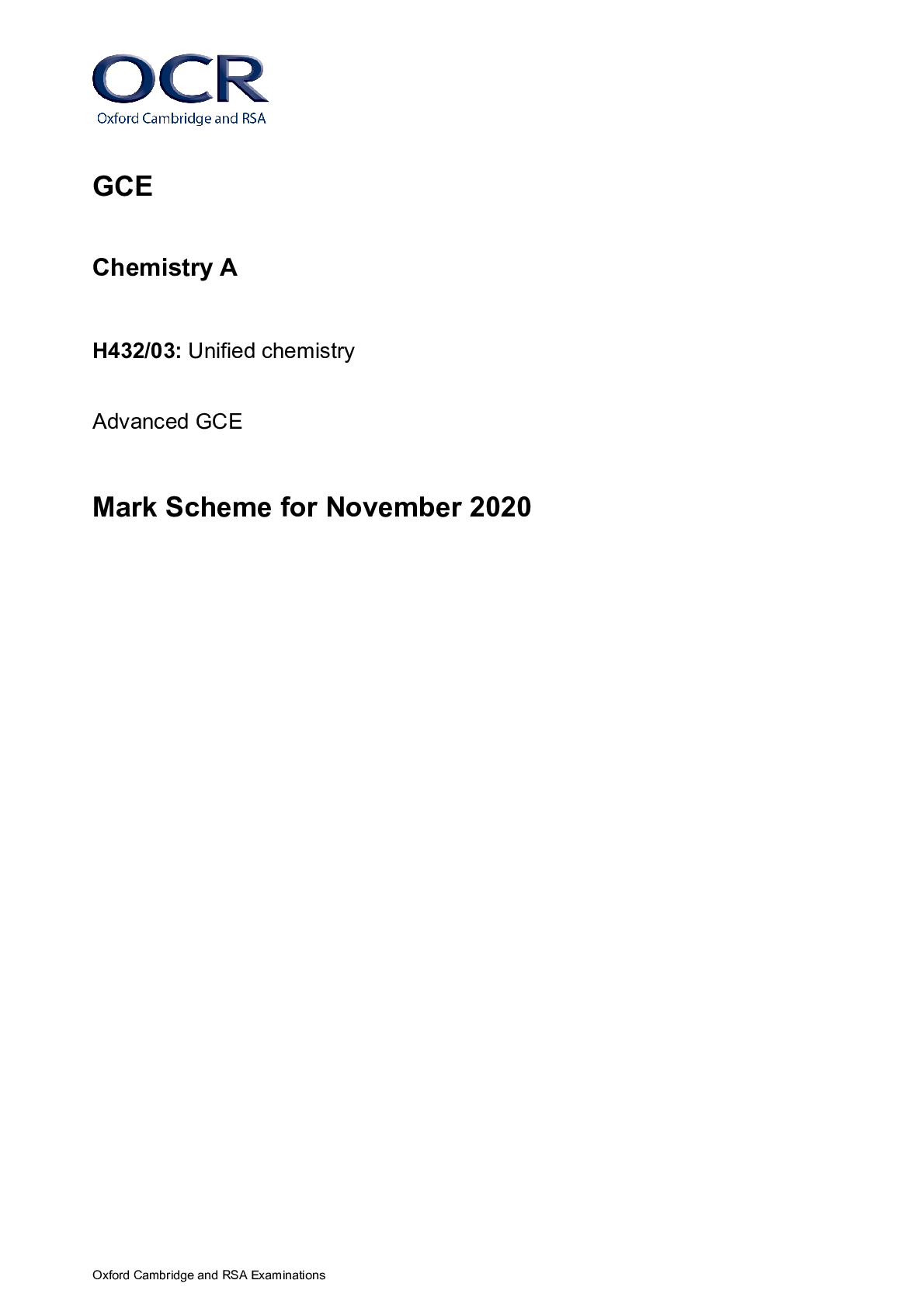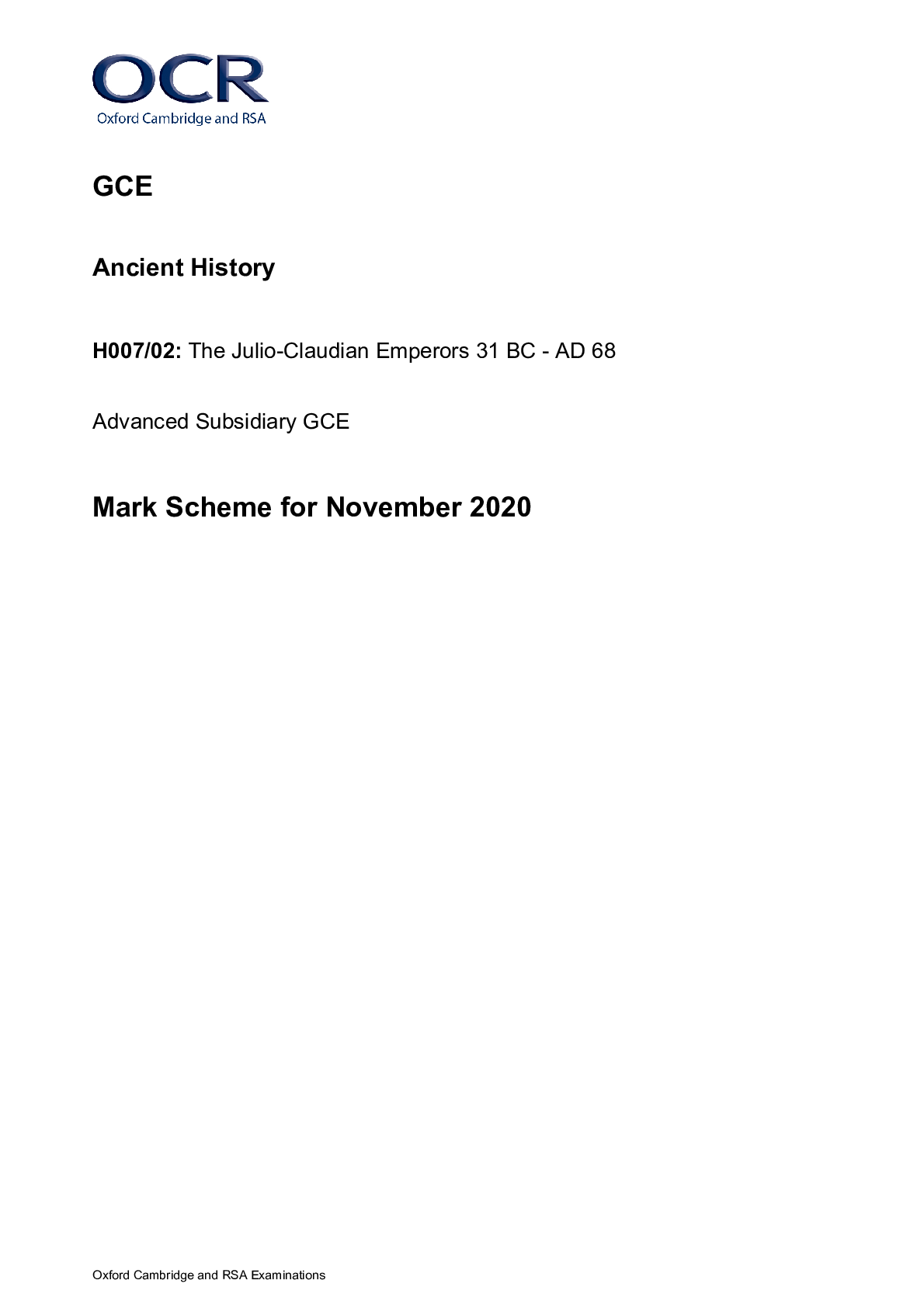OCR > A-Level Mark Scheme > OCR A Level Chemistry A H432/02: Synthesis and analytical techniques Mark Scheme for June 2022 (All)
OCR A Level Chemistry A H432/02: Synthesis and analytical techniques Mark Scheme for June 2022
Document Content and Description Below
A Level Chemistry A H432/02: Synthesis and analytical techniques Mark Scheme for June 2022 OCR (Oxford Cambridge and RSA) is a leading UK awarding body, providing a wide range of qual... ifications to meet the needs of candidates of all ages and abilities. OCR qualifications include AS/A Levels, Diplomas, GCSEs, Cambridge Nationals, Cambridge Technicals, Functional Skills, Key Skills, Entry Level qualifications, NVQs and vocational qualifications in areas such as IT, business, languages, teaching/training, administration and secretarial skills. It is also responsible for developing new specifications to meet national requirements and the needs of students and teachers. OCR is a not-for-profit organisation; any surplus made is invested back into the establishment to help towards the development of qualifications and support, which keep pace with the changing needs of today’s society. This mark scheme is published as an aid to teachers and students, to indicate the requirements of the examination. It shows the basis on which marks were awarded by examiners. It does not indicate the details of the discussions which took place at an examiners’ meeting before marking commenced. All examiners are instructed that alternative correct answers and unexpected approaches in candidates’ scripts must be given marks that fairly reflect the relevant knowledge and skills demonstrated. Mark schemes should be read in conjunction with the published question papers and the report on the examination. © OCR 2022 MARKING INSTRUCTIONS PREPARATION FOR MARKING RM ASSESSOR 1. Make sure that you have accessed and completed the relevant training packages for on-screen marking: RM Assessor Online Training; OCR Essential Guide to Marking. 2. Make sure that you have read and understood the mark scheme and the question paper for this unit. 3. Log-in to RM Assessor and mark the required number of practice responses (“scripts”) and the required number of standardisation responses. MARKING 1. Mark strictly to the mark scheme. 2. Marks awarded must relate directly to the marking criteria. 3. The schedule of dates is very important. It is essential that you meet the RM Assessor 50% and 100% (traditional 50% Batch 1 and 100% Batch 2) deadlines. If you experience problems, you must contact your Team Leader (Supervisor) without delay. 4. If you are in any doubt about applying the mark scheme, consult your Team Leader by telephone, email or via the RM Assessor messaging system. 5. Work crossed out: Crossed Out Responses Where a candidate has crossed out a response and provided a clear alternative then the crossed out response is not marked. Where no alternative response has been provided, examiners may give candidates the benefit of the doubt and mark the crossed out response where legible. Rubric Error Responses – Optional Questions Where candidates have a choice of question across a whole paper or a whole section and have provided more answers than required, then all responses are marked and the highest mark allowable within the rubric is given. Enter a mark for each question answered into RM assessor, which will select the highest mark from those awarded. (The underlying assumption is that the candidate has penalised themselves by attempting more questions than necessary in the time allowed.) Multiple Choice Question Responses When a multiple choice question has only a single, correct response and a candidate provides two responses (even if one of these responses is correct), then no mark should be awarded (as it is not possible to determine which was the first response selected by the candidate). When a question requires candidates to select more than one option/multiple options, then local marking arrangements need to ensure consistency of approach. Contradictory Responses When a candidate provides contradictory responses, then no mark should be awarded, even if one of the answers is correct. Short Answer Questions (requiring only a list by way of a response, usually worth only one mark per response) Where candidates are required to provide a set number of short answer responses then only the set number of responses should be marked. The response space should be marked from left to right on each line and then line by line until the required number of responses have been considered. The remaining responses should not then be marked. Examiners will have to apply judgement as to whether a ‘second response’ on a line is a development of the ‘first response’, rather than a separate, discrete response. (The underlying assumption is that the candidate is attempting to hedge their bets and therefore getting undue benefit rather than engaging with the question and giving the most relevant/correct responses.) Short Answer Questions (requiring a more developed response, worth two or more marks) If the candidates are required to provide a description of, say, three items or factors and four items or factors are provided, then mark on a similar basis – that is downwards (as it is unlikely in this situation that a candidate will provide more than one response in each section of the response space.) Longer Answer Questions (requiring a developed response) Where candidates have provided two (or more) responses to a medium or high tariff question which only required a single (developed) response and not crossed out the first response, then only the first response should be marked. Examiners will need to apply professional judgement as to whether the second (or a subsequent) response is a ‘new start’ or simply a poorly expressed continuation of the first response. 6. Always check the pages (and additional objects if present) at the end of the response in case any answers have been continued there. If the candidate has continued an answer there then add a tick to confirm that the work has been seen. 7. Award No Response (NR) if: • there is nothing written in the answer space. Award Zero ‘0’ if: • anything is written in the answer space and is not worthy of credit (this includes text and symbols). Team Leaders must confirm the correct use of the NR button with their markers before live marking commences and should check this when reviewing scripts. 8. The RM Assessor comments box is used by your Team Leader to explain the marking of the practice responses. Please refer to these comments when checking your practice responses. Do not use the comments box for any other reason. If you have any questions or comments for your Team Leader, use the phone, the RM Assessor messaging system, or email. 9. Assistant Examiners will send a brief report on the performance of candidates to their Team Leader (Supervisor) via email by the end of the marking period. The report should contain notes on particular strengths displayed as well as common errors or weaknesses. Constructive criticism of the question paper/mark scheme is also appreciated. 10. For answers marked by levels of response: Read through the whole answer from start to finish, using the Level descriptors to help you decide whether it is a strong or weak answer. The indicative scientific content in the Guidance column indicates the expected parameters for candidates’ answers, but be prepared to recognise and credit unexpected approaches where they show relevance. Using a ‘best-fit’ approach based on the skills and science content evidenced within the answer, first decide which set of level descriptors, Level 1, Level 2 or Level 3, best describes the overall quality of the answer. Once the level is located, award the higher or lower mark: The higher mark should be awarded where the level descriptor has been evidenced and all aspects of the communication statement (in italics) have been met. The lower mark should be awarded where the level descriptor has been evidenced but aspects of the communication statement (in italics) are missing. In summary: The skills and science content determines the level. The communication statement determines the mark within a level. Level of response questions on this paper are 19(e) and 21 The only annotation on a level of response question should be the indication of the level. A level annotation should be used where all marks for a level have been achieved. e.g. if a candidate has 6 marks, they would have this annotation on their script: If a candidate has achieved 5 marks then they have reached Level 3 but will not have met the communication statement. They should have the following annotations on their scripts: The same principle should be applied to Level 2 and Level 1. No marks (0) should have a cross: Place the annotations alongside the mark for the question. On additional pages, annotate using 11. Annotations available in RM Assessor Annotation Meaning Correct response Incorrect response Omission mark Benefit of doubt given Contradiction Rounding error Error in number of significant figures Error carried forward Level 1 Level 2 Level 3 Benefit of doubt not given Noted but no credit given Ignore Blank page 12. Abbreviations, annotations and conventions used in the detailed Mark Scheme (to include abbreviations and subject-specific conventions). Annotation Meaning DO NOT ALLOW Answers which are not worthy of credit IGNORE Statements which are irrelevant ALLOW Answers that can be accepted ( ) Words which are not essential to gain credit Underlined words must be present in answer to score a mark ECF Error carried forward AW Alternative wording ORA Or reverse argument 13. Subject-specific Marking Instructions INTRODUCTION Your first task as an Examiner is to become thoroughly familiar with the material on which the examination depends. This material includes: • the specification, especially the assessment objectives • the question paper • the mark scheme. You should ensure that you have copies of these materials. You should ensure also that you are familiar with the administrative procedures related to the marking process. These are set out in the OCR booklet Instructions for Examiners. If you are examining for the first time, please read carefully Appendix 5 Introduction to Script Marking: Notes for New Examiners. Please ask for help or guidance whenever you need it. Your first point of contact is your Team Leader. SECTION A Question Answer Marks AO element Guidance 1 B 1 AO1.1 2 B 1 AO1.1 3 D 1 AO1.2 ALLOW 15 (correct number of sigma bonds) 4 A 1 AO1.1 5 D 1 AO1.2 ALLOW 8 (correct number of chiral centres) 6 B 1 AO1.2 7 D 1 AO1.2 8 C 1 AO2.2 ALLOW 500 (This is the correct mass) 9 C 1 AO2.6 ALLOW 4.8 (This is the correct volume) 10 B 1 AO1.2 11 B 1 AO2.5 12 A 1 AO2.1 13 D 1 AO1.1 14 A 1 AO1.1 15 B 1 AO2.1 Total 15 [Show More]
Last updated: 11 months ago
Preview 1 out of 35 pages
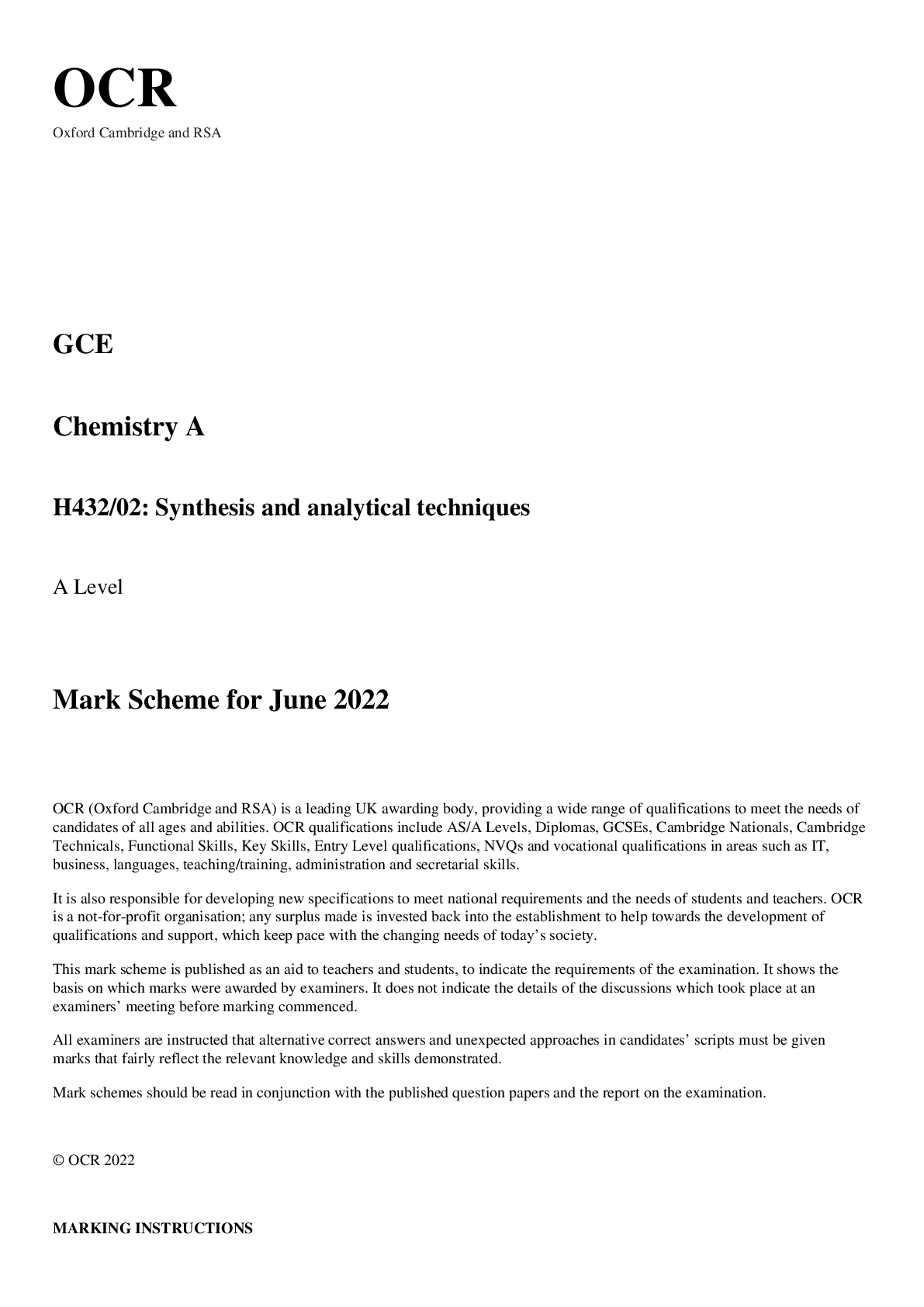
Also available in bundle (1)

OCR A LEVEL CHEMISTRY A PAPER 2 JUNE 2022 FINAL QUESTION PAPER AND MARK SCHEME.
OCR A LEVEL CHEMISTRY A PAPER 2 JUNE 2022 FINAL QUESTION PAPER AND MARK SCHEME.
By examstore001 11 months ago
$28
2
Reviews( 0 )
Document information
Connected school, study & course
About the document
Uploaded On
May 17, 2023
Number of pages
35
Written in
Additional information
This document has been written for:
Uploaded
May 17, 2023
Downloads
0
Views
54

